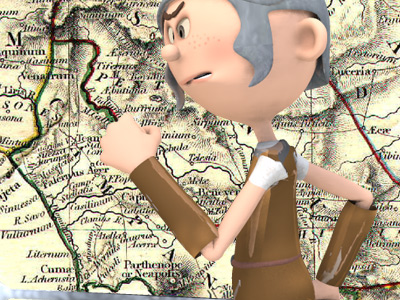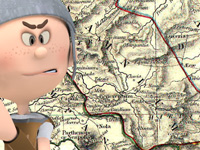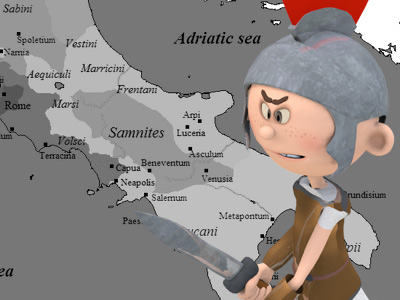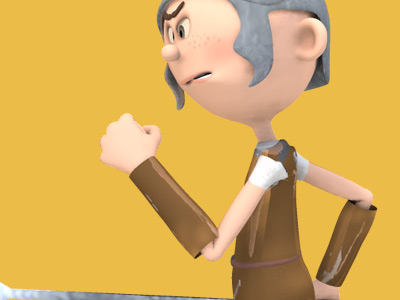Third Samnite War (298-290 BC)

295 BC The Etrurian Campaign and the Battle of Sentinum
The Samnite raids in Campania created great alarm in Rome. In addition to this, there was news that, following the withdrawal of Lucius Volumnius' army from Etruria, the Etruscans were arming themselves, had invited Gellius Egnatius' Samnites and the Umbrians to join them in revolt, and had offered large sums of money to the Gauls. Then there were reports of an actual coalition between these four peoples and that there was "a huge army of Gauls." It was the first time that Rome had to confront a coalition of four peoples. There was going to be the biggest war Rome had ever faced and the two best military commanders, Quintus Fabius Maximus Rullianus and Publius Decius Mus were elected as consuls again (for 295 BC). Lucius Volumnius' command was prolonged for a year. Quintus Fabius went to Etruria with one legion to replace Appius Claudius and left this legion in Clusium, too. He then went to Rome where the war was being debated. It was decided that the two consuls both fight in Etruria. They set off with four legions, a large cavalry and 1,000 Campanian soldiers. The allies fielded an even larger army. Lucius Volumnius went to Samnium with two legions. That he went with such a large force must have been part of a diversionary strategy to force the Samnites to respond to Roman raids in Samnium and limit their troop deployment in Etruria. Two reserve contingents headed by propraetors were stationed in the Faliscan district and near the Vatican Hill respectively to protect Rome.
Livy reported two traditions about events in Etruria early in 295 BC. According to one, before the consuls went to Etruria, a large force of Senones went to Clusium to attack the Roman The Roman Republic was a form of government of Rome and the era of the classical Roman civilization when it was run through public representation of the Roman people. Beginning with the overthrow of the Roman Kingdom (traditionally dated to 509 BC) and ending in 27 BC with the establishment of the Roman Empire, Rome's control rapidly expanded during this period - from the city's immediate surroundings to hegemony over the entire Mediterranean world. legion stationed there and routed it. There were no survivors to warn the consuls who were unaware of the disaster until they came across Gallic horsemen. According to the other one, Umbrians attacked a Roman foraging party which was relieved by assistance from the Roman camp.
The Roman Republic was a form of government of Rome and the era of the classical Roman civilization when it was run through public representation of the Roman people. Beginning with the overthrow of the Roman Kingdom (traditionally dated to 509 BC) and ending in 27 BC with the establishment of the Roman Empire, Rome's control rapidly expanded during this period - from the city's immediate surroundings to hegemony over the entire Mediterranean world. legion stationed there and routed it. There were no survivors to warn the consuls who were unaware of the disaster until they came across Gallic horsemen. According to the other one, Umbrians attacked a Roman foraging party which was relieved by assistance from the Roman camp.
The Etruscans, Samnites and Umbrians crossed the Apennine Mountains and advanced near Sentinum (in the Marche region, near modern Sassoferrato). Their plan was for the Samnites and Senones to engage the Romans and for the Etruscans and Umbrians to take the Roman camp during the battle. Deserters from Clusium informed Quintus Fabius about this plan. The consul ordered the legions in Falerii and the Vatican to march to Clusium and ravage its territory for another diversionary strategy. It drew the Etruscans away from Sentinium to defend their land. In the Battle of Sentinum, the Gauls stood on the right wing and the Samnites on the left. Quintus Fabius stood on the right and Publius Decius on the left. Livy said that the two forces were so evenly matched that if the Etruscans and Umbrians had been present it would have been a disaster for the Romans.
Quintus Fabius fought defensively to prolong the battle into a test of endurance and wait for the enemy to flag. Publius Decius fought more aggressively and ordered a cavalry attack, which drove back the Senone cavalry twice. The second time they reached the enemy infantry, but suffered a chariot attack and were scattered and overthrown. The line of the Decius’ infantry was broken by the chariots and the Senone foot attacked. Publius Decius decided to devote himself. This term referred to a military commander offering prayers to the gods and launching himself into the enemy lines, effectively sacrificing himself, when his troops were in dire straits. This act galvanised the Roman left which was also joined by two reserve contingents which Quintus Fabius had called in to help. On the right, Quintus Fabius told the cavalry to outflank the Samnite wing and attack it in the flank and ordered his infantry to push forward. He then called in the other reserves. The Samnites fled past the Senone line. The Senones formed a testudo (tortoise) formation – where the men aligned their shields in a compact formation covered with shields at the front and top. Quintus Fabius ordered 500 Campanian lancers to attack them at the rear. This was to be combined with push by the middle line of one of the legions and an attack by the cavalry. Meanwhile, Quintus Fabius took the Samnite camp by storm and cut off the Senones in the rear. The Senone Gauls were defeated. The Romans lost 8,700 men and their enemy 20,000.
Livy noted that some writers (whose work in lost) exaggerated the size of the battle, saying that the Umbrians also took part and giving enemy an infantry of 60,000 a cavalry of 40,000 and 1,000 chariots and claiming that Lucius Volumnius and his two legions also fought in the battle. Livy said that Lucius Volumnius, instead, was holding the front in Samnium and routed a Samnite force near Mount Tifernus. After the battle, 5,000 Samnites made their way back home from Sentinum through the land of the Paeligni. The locals attacked them and killed 1,000 men. In Etruria, the propraetor Gnaeus Fulvius defeated the Etruscans. Perusia and Clusium lost up to 3,000 men. Quintus Fabius left Publius Decius’ army to guard Etruria and went to Rome to celebrate a triumph. In Etruria Perusia continued the war. Appius Claudius was sent to head Publius Decius’s army as propraetor and Quintus Fabius confronted and defeated the Perusini. The Samnites attacked the areas around the River Liris (at Formiae and Vescia), and the River Volturnus. They were pursued by Appius Claudius and Lucius Volumnius, who merged their forces and defeated the Samnites in the vicinity of Caiatia, near Capua.
HISTORY

RESOURCES
This article uses material from the Wikipedia article "Samnite Wars", which is released under the Creative Commons Attribution-Share-Alike License 3.0.
© Stories Preschool. All Rights Reserved.











